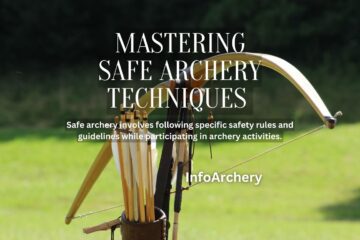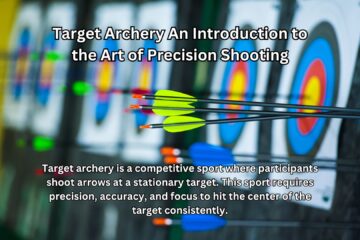Olympic archery is a competitive sport that involves shooting arrows at a target from a designated distance. Athletes must aim for the center of the target to score the highest number of points.
Archery has been a part of the Olympic games since 1900, and it has evolved over time. In the early days, athletes shot at distances of up to 90 meters using wooden bows and arrows. Today, they shoot at distances up to 70 meters with modern equipment made of lightweight materials.
To compete in Olympic archery, athletes must possess physical strength, mental focus, and exceptional hand-eye coordination. They use various techniques to shoot accurately, including the sight picture, anchor point, and release. In this article, we will explore the history of Olympic archery, the equipment used, and the rules and regulations of the sport. We will also discuss some of the top athletes and their achievements in Olympic archery.
The Evolution Of Olympic Archery
Since the first modern Olympics in Athens in 1896, archery has been one of the most popular and thrilling sports events. Known for its precision, grace, and endurance, archery has undergone significant changes in its rules, equipment, and technology over the years.
This post will explore the evolution of Olympic archery, focusing on the following subheadings.
Changes In Archery Rules And Equipment Over The Years
Archery has evolved significantly since its introduction in ancient times. The following are some of the most notable changes that have occurred in Olympic archery.
- In the first modern Olympics, archery was only a men’s event and featured just three types of bows: Longbow, American flatbow, and double York round bows. The distance was also shorter compared to today’s standards.
- In the 1920 Antwerp Olympics, women’s archery was introduced, and just like men’s, three types of bows were used.
- In 1931, the Federation Internationale de tir à l’arc (fita) was established. Fita standardized equipment and rules, which applied to archery events worldwide.
- In the 1970s, the recurve bow became the choice bow for competitive archers, replacing the older wooden bows. Recurve bows are made of modern materials, highly precise, and have a shooting mechanism that uses cams.
- In the 1990s, there was an introduction of electronic scoring systems that replaced the traditional paper-based methods.
The Introduction Of Compound Bows And Its Impact On Archery
Compound bows are a modern type of bow used in archery. They were first introduced in the us in the 1960s and eventually became popular in Olympic archery. Here’s how they have impacted the sport.
- Compound bows use a pulley and cable system that reduces the force needed to get the arrow moving. This makes them easier to shoot accurately and consistently.
- They can be adjusted to fit the archer’s preferences, which makes them user-friendly.
- They have higher draw weights and arrow speeds compared to recurve bows.
- The use of compound bows led to the introduction of new events in archery–team and mixed-team events.
The Impact Of Technology On Archery
Technology has played a crucial role in archery. Here’s how technological advancements have impacted the sport.
- The use of modern materials has led to the manufacturing of lighter, more durable, and precise bows. Archers can now adjust their bows to suit their style and preference.
- Advanced scoring systems have made it easier to keep track of scores, reducing errors resulting from manual scoring.
- Introduction of video technology has also made it possible for archers to observe their form in slow motion and identify areas they need to improve.
Overall, the evolution of Olympic archery has been remarkable. With technological advancements, the sport has become more accessible, precise, and globally competitive. With this changing trend, it will be interesting to see what the future holds for Olympic archery.
The Importance Of Precision In Olympic Archery
Olympic Archery: The Importance Of Precision
Archery is an ancient practice, dating back to the Paleolithic era, where the bow and arrow were used as a weapon for hunting and warfare. Today, this traditional activity has evolved into a competitive sport, where athletes from around the world compete for the gold medal in Olympic archery.
The sport requires precision, aiming skill, patience, and focus. In this blog post, we will discuss the importance of precision in Olympic archery, scoring system, role of precision in achieving high scores, and techniques used to achieve precision in Olympic archery.
The Scoring System In Olympic Archery
The scoring system in Olympic archery consists of a target with ten concentric rings, with each ring awarded a specific score, from 1 to 10. If the arrow lands on the line between two rings, the higher score is awarded.
In the finals, archers shoot 12 arrows, and each arrow carries a maximum of ten points, making the highest possible score 120.
The Role Of Precision In Achieving High Scores
Archery is a sport where the margin for error is very small. The slightest deviation in the angle or release of the arrow will cause it to miss the target, which is why precision is essential. The archer must have complete control over their body and their equipment to achieve consistent, accurate shots.
Precision is vital for string alignment, grip, posture, and follow-through. A small error in any of these elements can cause the arrow to miss the target, resulting in a lower score.
Techniques Used To Achieve Precision In Olympic Archery
Archery requires a combination of mental and physical effort, and the following techniques are used to achieve precision in Olympic archery:
- Proper stance: A solid stance is crucial to maintain stability while shooting, so the archer can focus more on aiming.
- Consistent anchor point: Consistency in the anchor point helps archers maintain proper string alignment which leads to a consistent release of the arrow resulting in accurate shots.
- Release: The release is where precision becomes crucial. An archer must release the bowstring smoothly without jerking, as any sudden movement can impact the shot’s accuracy.
- Aiming: Proper aiming techniques help archers better focus on their target and improve accuracy. Consistent aiming can also help with developing muscle memory.
- Breathing: Archers will hold their breath during aiming. Controlled breathing ensures that the shooter’s arms, hands, and fingers do not move while aiming, thus ensuring a consistent aim over an extended period.
In Olympic archery, the most accurate archers who consistently score high, possess precision in their technique and their mindset, which is the result of many years of practice and experience. These archers understand the importance of precision in achieving high scores and master the techniques to maintain their consistency.
The scoring system, role of precision in achieving high scores and techniques used to achieve accuracy in Olympic archery outlined here should hopefully give you an insight into what it takes to be successful in this unique and challenging sport.
The Role Of Mental And Physical Conditioning In Olympic Archery
Olympic archery represents a remarkable feat, requiring the archers to exhibit high levels of mental and physical conditioning. In this post, we will delve deeper into how mental focus and physical conditioning play a critical role in Olympic archery performance.
Mental Focus And Its Impact On Archery Performance
Mental focus is the cornerstone of archery, and it accounts for about 90% of an archer’s success. Here are a few key points that you should keep in mind about mental focus in Olympic archery:
- Archers must be able to concentrate on the target while blocking out external distractions. It takes years of practice to develop this level of concentration.
- Anxiety, stress, and nervousness are common distractions that archers face. They must learn to control their breathing and heart rate to stay focused and calm during competition.
- Visualization exercises can help archers hone their focus and improve their mental performance. This technique involves imagining the perfect shot and executing it in your mind.
The Importance Of Physical Conditioning For Archers
Physical conditioning is equally critical for Olympic archers as it builds the foundation for their success. Here are a few crucial points that you should be aware of concerning physical conditioning for archery:
- Archers must follow a strict fitness regimen that includes cardiovascular exercises, strength training, and flexibility exercises. This regimen can vary depending on the athlete’s individual needs, but it usually involves building core stability, upper body strength, and endurance.
- Flexibility is essential for archers, as it allows them to move their bodies into the correct position to shoot an arrow accurately. Core stability helps them maintain balance during the shot, and upper body strength allows them to draw the bowstring back without straining their muscles.
- Proper nutrition is also critical for Olympic archers as it provides the necessary nutrients to support their training. A balanced diet should consist of protein, carbohydrates, healthy fats, and fiber.
Techniques Used To Improve Mental And Physical Conditioning For Archery
Improving mental and physical conditioning requires dedicated practice and attention to detail. Here are a few techniques that archers can use to enhance their performance:
- Meditation and breathing exercises can help archers improve their mental focus and stay calm under pressure during competitions.
- Visualization exercises can help archers envision the perfect shot and execute it in their mind, leading to better accuracy and precision during competitions.
- Strength training, cardiovascular exercises, and flexibility exercises can help archers improve their physical conditioning.
- Coaches play a significant role in an archer’s success, providing feedback, training, and guidance to help them achieve their full potential.
Mental and physical conditioning is critical to Olympic archery, and it requires years of dedicated practice and training to achieve success. By working on their mental focus, physical conditioning, and techniques, archers can achieve their goals and compete at the highest levels in the world of archery.
Notable Olympic Archery Moments
Olympic Archery
In the world of sports, archery is considered one of the oldest and most traditional games. The ability to take down a target from afar demands precision and accuracy that can only be achieved through years of practice. Archery has been an Olympic sport since 1900 and has continued to captivate audiences with some of the most memorable moments in sports history.
In this blog post, we’ll examine some notable Olympic archery moments.
Analysis Of Notable Olympic Archery Performances
Archery has been an integral part of the Olympic games and has given us some awe-inspiring performances. Let’s take a closer look at some of the most noteworthy archery performances in Olympic history:
- Kim Soo-nyung’s incredible performance in the 1988 Seoul Olympics, where she broke three world records and took home gold in both individual and team events.
- Marco Galiazzo’s triumph in the 2004 Athens Olympics, where he carried the Italian flag during the opening ceremony and beat out south korea’s im dong-Hyun, the world’s top-ranked archer, in a tense final match to win the individual gold medal.
- The united states’ Olympic archery team’s three gold medals, won at the 1984 los angeles Olympics. The team consisted of john williams, Darrell Pace, and Rick McKinney, and their success helped spur the development of the sport in the us.
Each of these performances showcases the incredible skill and talent required to be an Olympic archer.
How Precision Played A Crucial Role In These Performances
Archery requires accuracy and precision when aiming at the target. Olympic archers need to maintain their focus and nerves to hit the bullseye consistently. In these notable performances, precision played a crucial role, allowing the archers to overcome their opponents and clinch victory.
- Kim Soo-nyung’s three world records were made possible due to her precision and flawless aim throughout the competition.
- Marco Galiazzo’s final match against im dong-hyun was an intense display of accuracy as both archers battled it out to hit the center of the target.
- The us olympic archery team’s medals in 1984 were won due to their combined precision and consistency in hitting the target.
Without precision, each one of these performances would not have been possible.
The Impact Of These Performances On The Sport Of Archery
These notable performances have had an enormous impact on the sport of archery, inspiring future generations of archers and elevating the popularity of the sport. Here are some of the impacts of these moments:
- Kim Soo-nyung’s incredible performance in 1988 put archery on the map in south Korea and helped to popularize the sport in the country.
- Marco Galiazzo’s triumph in 2004 was a defining moment for archery in Italy, inspiring many young Italians to take up the sport.
- The us olympic archery team’s success in 1984 helped to revitalize the sport in the us and led to an increase in participation in archery programs across the country.
The moments mentioned above are a testament to the skills and talents of olympic archers. As the popularity of archery continues to grow, we can expect to see more unforgettable performances that inspire and excite audiences around the world.
Frequently Asked Questions On Olympic Archery
What Is Olympic Archery?
Olympic archery is a competitive sport where archers shoot arrows at a target from a set distance. The sport has been a part of the olympic games since 1900.
How Does Olympic Archery Work?
Olympic archery involves shooting arrows at a target from a distance of 70 meters in a series of rounds. Archers take turns shooting and earn points based on where their arrows land on the target.
What Equipment Do Archers Use In Olympic Archery?
Archers in olympic archery use bows, arrows, a quiver, an armguard, a finger tab or glove, and a sight. The equipment must meet specific regulations set by the international olympic committee.
What Is The History Of Olympic Archery?
Archery has been a part of the olympic games since the early 1900s, but it was removed in the 1920s and re-introduced in 1972. The sport has evolved over time, with changes to the equipment and rules.
What Makes Olympic Archery A Challenging Sport?
Olympic archery requires focus, precision, and physical stamina. Archers must have the ability to remain calm under pressure and execute consistent shots throughout the competition. The sport requires a combination of mental and physical strength.
Conclusion
Ultimately, olympic archery is an exciting sport that combines physical and mental strength, precision, and focus. Athletes from all over the world come together every four years to compete on the global stage, and fans eagerly watch to see who will emerge victorious.
Whether you’re a seasoned archery enthusiast, a casual sports fan, or simply curious about the sport, olympic archery has something to offer. From the impressive feats of strength and accuracy to the fascinating mental challenges faced by athletes, it’s a unique and inspiring experience.
While there may be some challenges associated with training for and competing in olympic archery, the rewards are well worth it for those who have what it takes to succeed. So whether you’re cheering on your favorite athlete or dreaming of taking up the sport yourself, olympic archery is sure to capture your imagination.







